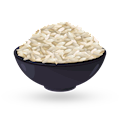Hailing from Hejaz, saleeg is a traditional Arabian rice dish consisting of creamy, porridge-like short-grain rice and roasted meat. Chicken is the most common meat choice, and it is typically boiled in water with spices before it is roasted. This dish uses a combination of the broth in which the meat has been cooking, hot water, and optional mastic tear to boil the rice.
The boiled rice is then combined with milk and ghee or butter, and cooked until it reaches the desired consistency. A large serving platter (tabasi) is traditionally used for serving saleeg, and the roasted meat is usually placed on top of the rice.
Sekihan is a traditional dish consisting of only two main ingredients – glutinous rice and red azuki beans. The dish has a reddish hue which is a result of the cooking liquid from azuki beans. In the past, the color red was a symbol of good fortune and it supposedly warded off evil.
Nowadays, sekihan is typically consumed for good luck – it is served mostly on special occasions such as birthdays, weddings, and celebrations. The dish is usually served on okuizome (a baby's first meal when it is 100 days old) and shichi-go-san (a ritual for children aged 3, 5, and 7).
Khao khluk kapi is a Thai rice dish made with cooked rice that is fried with shrimp paste, and then topped with or served alongside a number of ingredients, including crispy dried shrimps, slices of sweet pork or chicken, chilis, raw mango gratings, red onions, omelet shavings, cucumbers, green onions, and cilantro.
All these ingredients combined into one make for a colorful dish and create an explosion of flavors and textures in the mouth. This delicious rice and shrimp paste dish is usually sold as a takeaway food at many street stalls throughout Thailand.
Chūkadon is a Japanese dish which consists of stir-fried ingredients served over rice. It is believed that chūkadon originated in the 1930s in a Chinese-style restaurant in Tokyo. The dish can employ a variety of seafood ingredients, meat, and sliced vegetables which are shortly stir-fried in a thick and starchy soy-infused sauce.
Simple and easy to prepare, chūkadon is commonly found on the menus of many Japanese fast food establishments.
Nasi jagung is a traditional rice dish originating from Indonesia. This simple dish is made with a combination of rice, sweet corn kernels, and water. The rice and corn are boiled in water and stirred from time to time until the corn is fully cooked and the rice is dry and fluffy.
Nasi jagung is stirred well and then served while still hot. This dish is popular in areas where rice is difficult to obtain or expensive, so corn is used to add bulk to the rice.
Injeolmi are traditional South Korean steamed rice cakes. They are prepared by steaming and pounding rice into a pliable dough which is then rolled and generously dusted with roasted soybean powder. The varieties include ssuk injeolmi, which incorporates mugwort powder, or kkaeinjeolmi, which is dusted with black sesame.
According to a legend, these cakes were invented by a commoner Yim who offered them to the king Injo after he fled Seoul due to a rebellion. To show his appreciation, the king named the dish after its inventor. Nowadays, injeolmi is mainly enjoyed on special occasions, and it is usually served sliced into bite-sized rectangular pieces.
Turkey rice is a simple Taiwanese dish which incorporates shredded turkey meat served over plain boiled rice. Next to tender pieces of steamed turkey and rice, the dish is traditionally topped with soy sauce-flavored drippings and it is usually accompanied by daikon radish.
Turkey rice originated in the Taiwanese province of Chiayi as a frugal and straightforward meal that has quickly become one of the most famous dishes in the country. It is usually enjoyed as a late night snack and can be found at many street food stalls and traditional Taiwanese markets.
MAIN INGREDIENTS
Thengai sadam is a traditional rice dish originating from the southern parts of the country. The base of the dish consists of rice and grated coconut, and it's then seasoned with a variety of ingredients such as cumin, mustard seeds, hot peppers, ginger, asafoetida, curry leaves, salt, oil, and cashews.
Once stir-fried and cooked until done, thengai sadam is typically served with flatbreads or curries on the side.
MAIN INGREDIENTS
Panta bhat is a simple rice dish prepared by first cooking the rice, rinsing it, and then soaking it in water overnight. The dish is rich in minerals, and it is believed to have health-beneficial effects. Because it is usually enjoyed chilled, it is a favorite summer treat, and apart from being a typical everyday breakfast, it is also regularly prepared for special occasions such as Bengali New Year and Pahela Baishakh festivity.
The dish is usually topped with fresh green chili peppers, salt, and onions, and when served with fried ilish fish it goes under the name panta ilish.
MAIN INGREDIENTS
Mıcırık aşı is a traditional dish originating from Gaziantep. This stew is usually prepared with a combination of eggplants, rice, onions, tomato paste, bell peppers, garlic, olive oil, lemon juice, salt, paprika, and mint. The onions and garlic are sautéed in olive oil, then mixed with the tomato paste and bell peppers that are fried in the same pot.
The mixture is covered with water, and the eggplants and rice are added to the pot. The dish is cooked until the rice becomes tender, and lemon juice is then mixed into the stew. Once served, mıcırık aşı is traditionally drizzled with the sauce consisting of olive oil, paprika, and mint.
TasteAtlas food rankings are based on the ratings of the TasteAtlas audience, with a series of mechanisms that recognize real users and that ignore bot, nationalist or local patriotic ratings, and give additional value to the ratings of users that the system recognizes as knowledgeable. For the “82 Worst Rated Asian Rice Dishes” list until April 19, 2025, 18,135 ratings were recorded, of which 11,871 were recognized by the system as legitimate. TasteAtlas Rankings should not be seen as the final global conclusion about food. Their purpose is to promote excellent local foods, instill pride in traditional dishes, and arouse curiosity about dishes you haven’t tried.




































































































